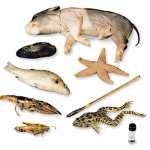Zoology
|
16 november 2013 11:26:36 |
| Causes of mortality and pathological lesions observed post-mortem in red squirrels (Sciurus vulgaris) in Great Britain (BMC Veterinary Research) |
|
Tweet Background:
The red squirrel population in Great Britain has declined dramatically in recent decades, principally due to squirrelpox. Concern exists that red squirrels may become extinct nationally and, as there has been limited research in to diseases other than squirrelpox, this study aimed to identify additional causes of mortality.
Results:
Post-mortem examinations on 163 red squirrels found dead on Isle of Wight (IoW) England, in Scotland and at other locations in Great Britain showed that 41.7% (n = 68) were killed by road traffic and 9.2% (n = 15) by predators, principally domestic cats and dogs. The overall male/female ratio was 1.08/1. Fleas were recorded on 34.9% of IoW squirrels and on 43.8% of Scottish squirrels but sucking lice and ixodid ticks were only seen on Scottish squirrels. Bacterial infections were significant, particularly in association with respiratory disease (n = 16); two squirrels died of Bordetella bronchiseptica bronchopneumonia. Cases of fatal exudative dermatitis (n = 5) associated with a lukM-positive clone of Staphylococcus aureus occurred only on the IoW. Toxoplasmosis (n = 12) was also confined to IoW where it was responsible for almost one sixth (15.6%) of all deaths. Hepatozoonosis was common, especially in IoW squirrels, but was not considered a primary cause of mortality. Hepatic capillariasis affected four IoW squirrels and one from Scotland. Fungal infections included oral candidiasis, adiaspiromycosis and pulmonary phaeohyphomycosis. Neoplastic conditions diagnosed were: pulmonary carcinoma, gastric spindle cell tumour, renal papillary adenoma and trichoepithelioma. Epidermal hyperplasia of unknown aetiology was seen in squirrels showing crusty lesions of the ear pinnae on IoW (n = 3) and Brownsea Island (n = 1), associated in two cases with cutaneous wart-like growths. Miscellaneous diagnoses included chylothorax, electrocution, intussusception, suspected cholecalciferol rodenticide poisoning and foetal death and mummification. No cases of squirrelpox were diagnosed.
Conclusions:
Red squirrels in Britain suffer premature or unnatural mortality due to a number of conditions in addition to squirrelpox, many of which result, directly or indirectly, from human activities: road traffic trauma, pet predation, toxoplasmosis, trap injuries, rodenticide poisoning and electrocution accounted for 61% of all recorded mortality in this study. Red squirrels are also affected by several diseases of unknown aetiology which merit further research. |
| 118 viewsCategory: Medicine, Zoology |
 Correction: Urine neutrophil gelatinase-associated lipocalin (NGAL) as a biomarker for acute canine kidney injury (BMC Veterinary Research) Correction: Urine neutrophil gelatinase-associated lipocalin (NGAL) as a biomarker for acute canine kidney injury (BMC Veterinary Research)Simultaneous subchronic exposure to selenium and diazinon as possible risk factor for osteoporosis in adult male rats (Acta Veterinaria Scandinavica) 
|
| blog comments powered by Disqus |
MyJournals.org
The latest issues of all your favorite science journals on one page
The latest issues of all your favorite science journals on one page



